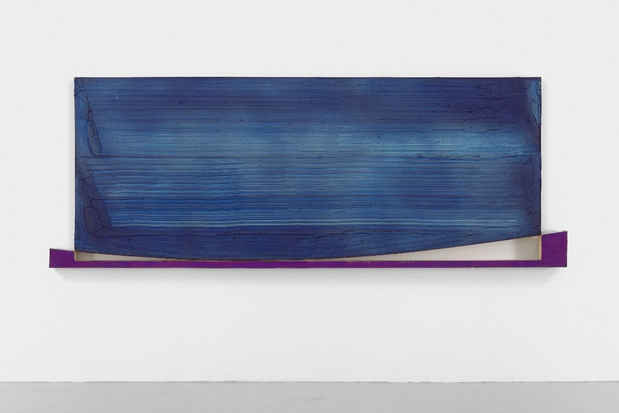Harvey Quaytman “Rockers and Pendulums, 1969-1977”
Van Doren Waxter (195 Chrystie St)

[Image: Harvey Quaytman "Mirror to Damascus" (1971) acrylic on canvas, 50 x 138 in. Courtesy Van Doren Waxter, NY.]
This event has ended.
Van Doren Waxter presents Harvey Quaytman: Rockers and Pendulums, 1969-1977, a self-professed “classical modernist”, helped to reshape the trajectory of American painting in the 1960s and 1970s with his monumental shaped canvases and is acknowledged for moving abstract painting into a more sculptural direction.
The curated gallery exhibition, which will include public programming on the artist’s legacy and influence, coincides with the artist’s first full-scale museum retrospective (October 17, 2018-January 27, 2019) at the Berkeley Art Museum and Pacific Film Archive (BAMPFA), CA organized by Apsara DiQuinzio. The highly anticipated survey is accompanied by the most in-depth scholarship to date edited by DiQuinzio (UC Press, 2018), examining the artist’s groundbreaking body of work and formal interests in shape, color, line, pattern, and surface.
The gallery show of six paintings and four works on paper, some of which have rarely been exhibited or reproduced, examines the period following Quaytman’s early exploration of Abstract Expressionism. Having moved from Cambridge, MA where he attended the School of the Museum of Fine Arts and Tufts University, to New York City in 1964, he began to isolate the curvilinear line from earlier work incorporating it into hand-built stretchers of shaped parts balanced one upon the other or attached in tandem to one another. The artist would begin a lifelong experiment with color during this time, and the works evince a range of chromatic effects. Untitled, 1971 is a painting of extraordinary scale (50 x 136 inches) and color in two parts: the shield form painted with wall paper brushes in cobalt blue creating a rough-hewn surface peppered with lumps of pigment delicately situated on points of the separate but attached supporting cradle. The curve of the shield is not symmetrical emphasizing the objectness or otherness of the forms starkly protruding from the wall.
The arc or curve was key to the artist’s intention of creating movement in a static object. The four pendulum paintings in the exhibition are defined by a long neck ending in a foot that seems to set the painting in motion. The tops of the paintings have a perspectival folly implying volume. But as the eye travels to the foot of the painting the surface flattens out. These paintings are ingeniously composed of two forms, painted separately but whose gesture unites them as one. The artist has layered and scraped the surfaces with pigment suspended in Rhoplex with the intention of hiding nothing.
For Quaytman, working on paper was an eventual route to a more scultptural practice. The works on paper in the exhibition are both painted and drawn toggling between intense color and black and white. The painted rocker drawings display careful attention to the edge of the image, which is taped to allow a build-up of layers of paint emphasizing the physical presence of the image on the page. The pendulum drawings, noteworthy for their proximity to human scale, tell a different story. Quaytman uses drawing in charcoal to define a tilted rectangle. Within that form emerges the finished form of the irregularly shaped pendulum paintings. The drawings are mad with balsa wood to give the line a subtle bas relief.
In the artist’s words: ‘My paintings mean to me my victory, inch by inch and year by year, over the arbitrary chaos of visual life. I have slowly taken command of a way of ordering my composition so that with the slightest shift of shaped colored areas I can break symmetry or stasis or even death. My meaning resides in my own victory over the inert.’
One of Quaytman’s daughters and an artist in her own right, R.H Quaytman, has contributed an essay to the new, scholarly catalog accompanying her father’s first posthumous museum retrospective.
“+ x, Chapter 34” will be presented at the Solomon R. Guggenheim Museum in conjunction with Hilma af Klint: Paintings for the Future, at the same time as her father Harvey Quaytman’s New York gallery presentation and BAMPFA exhibition. R.H. Quaytman discovered af Klint in 1988 after her father, returning from a trip to Sweden, presented her with a small catalog of the artist’s work.
Born in Queens, NY to Polish-Russian Jewish immigrants, Harvey Quaytman (1937-2002) has had more than sixty solo gallery exhibitions in different parts of the world including New York, Los Angeles, London, Berlin, Cologne, Paris, Copenhagen, Stockholm and Oslo. He is represented in many museum collections worldwide such as the Carnegie Museum of Art, Pittsburgh, PA; Harvard Art Museums, Fogg Art Museum, Harvard University, Cambridge, MA; Houston Museum of Fine Arts, Texas; The Israel Museum, Jerusalem; Louisiana Museum of Modern Art, Humlebaek, Denmark; Museum of Modern Art, New York; the National Gallery of Australia, Canberra; Phillips Collection, Washington, DC; Tate Gallery, London, England; Whitney Museum of American Art, New York; Yale University Art Gallery, New Haven, CT.
Media
Schedule
from October 04, 2018 to November 03, 2018
Opening Reception on 2018-10-10 from 18:00 to 20:00